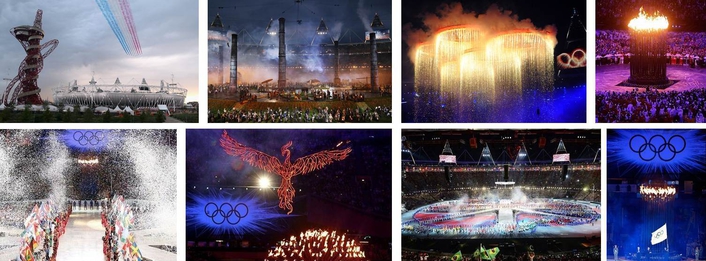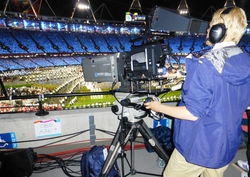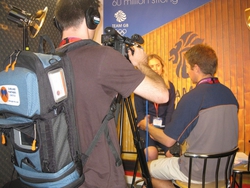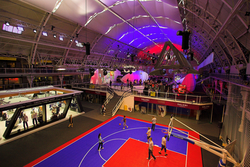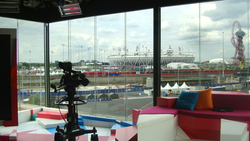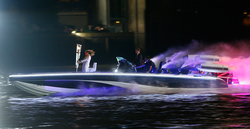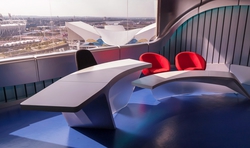Olympic Games 2012 in London - A Review
posted:
BBC Sport Makes Television History Once Again
BBC Sport Makes Television History Once Again
In 1948, the Games of the XIV Olympiad in London became the first-ever Olympics to offer live television coverage transmitted to the home. As the host broadcaster, the BBC delivered 60-plus hours of programming — including the first multicamera Olympics-event coverage — to more than a half million viewers within a 50-mile radius of London. Sixty-four years later, the Games have returned to London, and the BBC has once again taken a giant leap forward in the evolution of Olympic television production. By the time the Closing Ceremony concludes on Sunday, BBC Sport had delivered more than 2,500 total hours of live Olympic programming over 17 days (1,000 more than from Beijing). In addition to 18 hours of coverage per day on BBC1 and BBC3, the BBC allowed UK viewers to watch every minute of the Games live via 24 dedicated “Red Button” channels (available to Sky, Virgin, and Freesat subscribers) that were also streamed to the Web and to mobile devices and tablets.
BBC Sport Makes Television History Once Again
The International Broadcast Center at the Olympic Games 2012
Olympic Broadcasting Services (OBS), the host broadcasting organisation in charge of the London 2012 Olympic Games, appointed EVS to provide technology solutions and support services to guarantee the high standing production of Olympic international broadcast feeds, as well as a multitude of media exchange and service delivery for the international broadcast community.
IBC Operations Overview
As part of the global contract with OBS, EVS was providing and setting up the London 2012 Media Server at the heart of OBS’ operations. Besides fulfilling the requirements of OBS’ multilateral operations at the IBC, the London 2012 Media Server was also provided as a rate card facility to RHBs for their unilateral productions. The Media Server provided by EVS was a unique media exchange platform with associated software tools providing a wide range of services and applications including:
• HD-SDI ingest of feeds from different venues
• Permanent central storage
• Video logging and interfacing with the Olympic Data Feed
• Client browsing and delivery
• OBS multilateral production editing media exchange
• OBS 3D multilateral production packages
• Multi-dispatch playout
• Olympic News Channel 24/7 playout system
• Backup and archiving
The International Broadcast Center at the Olympic Games 2012
advertisment
Usain Bolt Wins Gold In 100 Meters
Racing against a star-studded field in which every qualifier ran faster than 10 seconds in the semifinal, Bolt successfully defended his 2008 gold medal in the 100 meters by setting a new Olympic record of 9.63 seconds. Yohan Blake of Jamaica took silver in 9.75 seconds, with Justin Gatlin of the United States capturing bronze in 9.79 seconds. A training partner of Bolt, Blake equalled a personal best with his runner-up time. Also setting or equalling personal best times were Gatlin and Ryan Bailey of the United States, who finished fifth. Of course, with a who's who of international track stars -- largely hailing from the United States and Jamaica -- it was no surprise to see the scoreboard light up with such stellar times. "It will take a 9.7 to even get a medal. It's mind blowing," Tyson Gay of the United States told the Daily Mail shortly before the Games. Gay burned to a personal season's best 9.80 to finish fourth. True to his prediction, all top three finishers crossed the line under 9.8 seconds.
Usain Bolt Wins Gold In 100 Meters
Riedel at the London Olympic Games
From January 2011 until the end of this year the intercom specialist Riedel was (and will be) on location to guarantee critical communication services for the LOCOG (London Organising Committee of the Olympic and Paralympic Games). A staff of 140 Riedel employees supported
· Airwave, a provider of high quality critical voice and data communications network and a UK sponsor of the LOCOG
· The Ceremonies Project for the opening and closing events for the Olympic and the Paralympic Games
· The CCTV cameras at the Olympic Stadium
· The wireless transmission of camera signals from five CatCam systems ( Greenwich Park, Eton Dorney, Hadleigh Farm, Lee Valley and Olympic Stadium)
· SportsMark – the Olympic marketing and event management services
Riedel at the London Olympic Games
advertisment
AEQ Phoenix Audiocodecs in London 2012
Broadcast operations at large international events such as the Olympic Games always present challenges of scale. One of them is the distribution of thousands of audio circuits from different sources (commentary, International Sound, PA, etc.) to all of the Rights Holding Broadcasters. The audio signals are generated by the Host broadcasting organisation at the Rights Holding Broadcasters commentary positions at the different venues and through the AEQ commentary system. All circuits from every venue are sent to the IBC (International Broadcasting Centre) and specifically to the CSC (Commentary Switching Centre) through AEQ BC 2000D routers. This we call Contribution. Once all the circuits from the venues have arrived, they are sorted at Concentration and then they go through an AEQ TITAN Router of 5000x5000 audio circuits and that handles the circuit switching, ensuring that each circuit reaches its respective destinations and according to the planning of the Host Broadcasting Organisation. This switching is in most cases fixed, following an extensive and very rigorous planning, but can also be dynamic with circuits shared by several users at different times.
AEQ Phoenix Audiocodecs in London 2012
NAC Image Technology Captures Sporting Excellence in Ultra Slow Motion
NAC Image Technology is pleased to reveal that 22 of its Hi-Motion II™, Ultra Slow Motion camera systems have been used to capture some of the most iconic moments from the sporting summer so far in London. From track and field to aquatics, from the velodrome to the rigours of rowing and road cycling, the Hi-Motion II has found itself in the centre of this summer’s sporting action, capturing stunning images at up to 1,000fps. Two gyro-stabilised units have even been mounted on camera cars for tracking shots and increased manoeuvrability, while a further unit saw duty mounted on a Wescam XR in the prow of a pursuit boat at Dorney Lake. Hi-Motion II cameras were also at recent equestrian, triathlon, marathon, mountain bike, BMX, canoe slalom, basketball & gymnastic events.
NAC Image Technology Captures Sporting Excellence in Ultra Slow Motion
advertisment
Special Cameras at the London Olympic Games
XD motion, Deep Vision and LMC provided special camera equipment for the Olympic Games 2012 in London. Among the innovative system was a X fly camera above the Serpentine in Hyde Park. The X fly covered the Triathlon swimming and the Marathon swimming event by following the athletes 900m on their competition delivering excellent images from a new viewing point. The images were covered by a Sony F23 with a 22x Fujinon lens and transmitted wireless via a Link HD RF transmitter. Kitecam balloons delivered beauty shots from the Equestrian Cross Country event at Greenwich Park and from the Beach Volleyball matches at Horse Guards Parade. A Sony HDC-P1 with a Canon wide angle delivered its signals a fiber video/data/power cable from a height of 80 meters to the OBVans on the ground.
Special Cameras at the London Olympic Games
Kronomav Delivered Successful London Olympics in 3D
Kronomav’s technology was used in North Greenwich Arena Venue where it was done Gymnastics, Trampoline and Basketball, both male and female. 4 new robotized Rigs STC-303 were used as well as the new Stereo Image Processors (SIP-300). All the four rigs in Gymnastics were set up in Beam Splitter mode while in Basketball two of them were operated in side-by-side mode. The rigs worked with Thompson Grass Valley LDK-8000 cameras, however one of the rigs was set up with two LDK-8300 SuperSloMo Cameras that had an excellent performance with IN3D LIVE system. These SuperSloMo cameras were used for both live signal and slow motion replays. 68 hours were broadcasted in 3D from North Greenwich Arena (39 hours in Gymnastics, 5 hours Trampoline and 24 hours Basketball).
Kronomav Delivered Successful London Olympics in 3D
advertisment
SIS LIVE Supports the NHK Super Hi-Vision Team
Outside broadcast, satellite uplink, and product design specialist SIS LIVE has been supporting the BBC and NHK over the summer in their deployment of the new super hi-vision technology. Super hi-vision is one of the new technologies showcased this summer, with selected events, including the Opening and Closing ceremonies and the Men’s 100m final being broadcast live in super hi-vision at special screenings around the UK, as well as at locations in Japan and the USA. Throughout July and August, London provided a spectacular showcase and backdrop for the SHV technology, which broadcasts pictures at 8 times the resolution of HD, and delivers sound at 22.2 (compared to 5.1 surround). The quality is at the limit of what the human eye can register, so this really is the pinnacle of high definition broadcasting.
SIS LIVE Supports the NHK Super Hi-Vision Team
Olympic Summer Sports 2012
At the first Olympic Games, nine sports were contested. Since then, the number of sports contested at the Summer Olympic Games has gradually risen to twenty-eight on the program for 2000-2008. At the 2012 Summer Olympics, however, the number of sports will fall back to twenty-six following an IOC decision in 2005 to remove baseball and softball from the Olympic program. These sports retain their status as Olympic sports with the possibility of a return to the Olympic program in future games. At the 121st IOC Session in Copenhagen on 9 October 2009, the IOC voted to reinstate both golf and rugby to the Olympic program, meaning that the number of sports to be contested in 2016 will be back up to 28 again. The IOC has put a limit of 28 sports in the Summer Olympics, therefore no further sports may be added unless existing sports are removed. In order for a sport or discipline to be considered for inclusion in the list of Summer Olympics sports, it must be widely practiced in at least 75 countries, spread over four continents. Women's sports or disciplines may be considered if practiced in at least 50 countries.
Olympic Summer Sports 2012
advertisment
Tiffen Covers the Press Photographers Who Cover the London 2012 Games
The Tiffen Company, a leading manufacturer and distributor of award-winning accessories for the still imaging, video, motion picture and broadcast markets, is pleased to announce that the London Organising Committee of the Olympic and Paralympic Games (LOCOG) chose to supply the 4,000 Official Press Photographers covering the London 2012 Olympic Games with Tiffen’s highly popular Domke PhoTOGS Vests. When LOCOG was looking for a supplier of photographers' vests, they naturally turned to The Tiffen Company and chose the Domke PhoTOGS Vest, the vest of choice for so many press photographers throughout the world. Put to the test during the world’s most-watched sporting event, the Domke PhoTOGS Vest earned a gold medal of its own, proving through its versatility and durability that it was more than capable of helping photographers catch every action-packed moment of the 2012 London Olympic Games.
Tiffen Covers the Press Photographers Who Cover the London 2012 Games
Getting to the Heart of London2012
When London 2012 ends, the International Olympic Committee expects that almost five billion people in more than 200 countries will have watched the Olympic Games. So, with more than 13,000 accredited broadcast personnel anticipated to exceed 61,000 hours of broadcast time, finding a competitive broadcasting advantage is essential for members of global online and traditional media outlets. Many have found the answer in a backpack from UK-provider, Garland Partners Limited. The team at Garland Partners has supplied 46 global media outlets with more than 100 LiveU units. The units — that can be carried around in a backpack — allow reporters in the field to send video by cellular signals back to their studio so that they can be transmitted out live to viewers. Media outlets no longer need satellite trucks stationed near their camera operators. Instead, they are free to follow the crowds and events as they happen and where they happen.
Getting to the Heart of London2012
advertisment
Czech Point Robe Gets Gold Medal in London
Czech technical solutions Provider AV Media invested in a substantial amount of new Robe moving lights and Anolis LED fixtures which is installed at the ‘Czech House’ Pavilion a base for all sports fans and supporters of the Czech National Team during the London Olympics. Czech National TV’s Olympic broadcast studio is located there, and the Pavilion features massive screens so the public can enjoy all the best of the Olympic action, together with food, beer, wine and digestives, chess, streetball, art, Czech Team merchandising and a host of other cultural offerings including a stage for live bands, DJs and other entertainment, with sociability high on the agenda. AV Media’s Project Manager Filip Klein explains that when they won the contract to co-ordinate all the technicals for the Czech House, it was a ‘no brainer’ that they would specify lighting from the Czech Republic’s best known entertainment technology manufacturer!.
Czech Point Robe Gets Gold Medal in London
Rosco Helps Global Broadcasters Capture Their Olympic VIEW
London’s Olympic Stadium has become the jewel of London during this year’s Olympic Games and every broadcaster wants to have the stadium, or other elements of Olympic Park, behind their anchors while they record their coverage of the 30th Olympiad. Studio space around the stadium is limited, so broadcasters began looking for alternative solutions. The BBC for instance leased the roof and 22nd floor of a local office building and Al Jazeera built a studio on top of a 24 story apartment building because “they liked the view.” After going out of their way to make sure the imagery behind their anchors is perfect, broadcasters from around the globe needed to make sure the windows of their studio aren’t blown out by the brightness of the exterior light. Some studios, such as Telemundo turned to simple products like Rosco N.6 Roscolex Acrylic Panels.
Rosco Helps Global Broadcasters Capture Their Olympic VIEW
advertisment
SIS LIVE Operates the First Mobile TV Studio for France TV Sports
Commissioned by France TV Sports, SIS LIVE’s British and French divisions have collaborated to design, construct and operate a live moving TV studio to deliver coverage of the London 2012 Olympics. Using state-of-the-art RF H264 technology and the expertise of SIS LIVE’s Comms specialists this vehicle is able to produce and transmit live TV while on the move, making dynamic use of 4 fixed receive high points around London which deliver RF coverage on selected routes around the city centre. This intelligent use of technology alleviates the need to employ a costly fixed wing aircraft relay solution, making this type of transmission a more viable prospect. The routes, which included Parliament Square, Hyde Park, Pall Mall, Piccadilly Circus, Embankment and the Tower of London, have been chosen to provide iconic London backdrops to the mobile bus broadcasts. Programmes and inserts from the bus were received by the SIS LIVE city-wide network and connected directly to France TV Sport’s London Olympic base for onward fibre transmission and subsequent broadcast on TV and online.
SIS LIVE Operates the First Mobile TV Studio for France TV Sports
France TV Rolls Onto the Streets of London with AJA Ki Pro
The Olympic Torch on its Way to the Olympic Stadium
Secrecy surrounding Friday night's Opening Ceremony of the London Olympics meant that camera crews were called at short notice. Outside Broadcast and studio facilities company, NEP Cymru, contacted BSI to provide radio cameras to film the sequence where a speedboat, driven by David Beckham, carries the Olympic flame up the river Thames. BSI's Technical Director, Tony Valentino, explains: "We were very excited when NEPC contacted us 10 days before the Opening Ceremony to provide four RF Cameras and an HD receive point for a helicopter, for what we understood to be a critical part of the ceremony." BSI used four radio camera systems including their own in house developed UHF camera control which allows the use of manufacturers' remote control panels (RCP). Cameras were located on HMS Belfast, Tower Bridge, Butler's Wharf and on the 87th (top) floor of the Shard - the first time the landmark location was used for broadcasting live pictures.
The Olympic Torch on its Way to the Olympic Stadium
advertisment
More than 50 Lawo Systems for the Sound of Sports
From the Opening ceremony and encompassing a wide range of sports activities, including Basketball, Football, Athletics, Badminton, Handball, Gymnastics, Table Tennis, Canoe / Kayak, Cycling, and Beach Volleyball, Lawo mc²56, mc²66, mc²90, crystal, and sapphire consoles, plus Nova73 HD routing systems play an integral role behind the scenes. Throughout the European broadcast community, Lawo systems are found in abundance. German public broadcasters ARD and ZDF both deliver from the control room in the IBC (International Broadcast Center) and rely on Lawo technology. Audio is mixed in ARD and ZDF’s Mobile Production Unit on a mc²90 and a mc²56 and added to the broadcast output in the HD control room. A redundantly designed Nova73 HD serves as the router.
More than 50 Lawo Systems for the Sound of Sports
Mission Possible: London 2012 Driven by Pyramix
Australian event experts, Norwest Productions just completed their latest Olympic triumph. Last weeks closing show for the Paralympics was the latest in a remarkable run of major events managed by Norwest since the Sydney games in 2000. Since Athens in 2004, Pyramix has been literally running the show. Merging Technologies’ flagship DAW plays back the pre-recorded audio for the show and the timecode output drives the broadcast and event timing. Danny Boyle’s acclaimed opening show required a far more complex set-up than previous games so the Pyramix was expanded and upgraded before the event to allow 128 channels of audio to be played back. The job of specifying what was needed fell to another member of the team, Auditoria’s Scott Willsallen, who had responsibility for the total audio installation in the stadium and the sound designer was Bobby Aitken. Norwest provided the technical heart of the installation but more equipment and expertise was provided by local companies Delta Sound, Britannia Row and Autograph.
Mission Possible: London 2012 Driven by Pyramix
Optocore Adds More Rings to the London Olympics
The awe-inspiring — and completely distinctive — Opening and Closing Ceremonies, which spectacularly book-ended the London 2012 Olympics, was a triumph for the respective artistic directors, Danny Boyle and Kim Gavin. Described as the most creative yet, to ensure the realisation of these ambitious concepts, the sound and lighting designers were also faced with enormous technical challenges. Specialising in this scale of event production for more than a decade, Australian company Norwest Productions again teamed up with their UK partners Delta Sound to provide the necessary Optocore fibre signal transport, custom RF solutions and LAN networking. This sophisticated connectivity realised the sound design conceived by fellow Australian Scott Willsallen (of Auditoria) — another with a string of Games Opening/Closing events on his CV — in conjunction with theatre sound designer, Bobby Aitken.
Optocore Adds More Rings to the London Olympics
Broadcast Rental Installs Complete Video Configuration During London Games
The London Games have been a success for Broadcast Rental. This Dutch based company specialised in rental of integrated video systems and professional equipment, installed all infrastructure for the Dutch broadcaster NOS. Broadcast Rental has set up a configuration for the distribution of the 40 video streams that NOS used. This configuration is also being used during the Paralympics. The entire operation is a big step forward for Broadcast Rental for the rental of complete video systems for all sorts of major events. Broadcast Rental not only delivered two EVS XT[3] servers, three edit suits and two voice over suits, but also the video and audio patch fields embedders, de-embedders and two 46 inch 32 channel multi viewers. In addition to that the company installed a 108x108 Universal Videohub for the distribution of signals from the Olympic Broadcast Services (OBS) between Holland Heineken House, Medal Plaza and IBC. The final output was routed back via an EVS IPDirector and the videohub to the broadcast network in The Netherlands.
Broadcast Rental Installs Complete Video Configuration During London Games
TSL Installed Temporary Olympic Broadcast Facility for Globosat
Owned by Globosat, SporTV is Brazil's most popular sports channel and covers more than 4000 events, transmitting more than 30 live sports categories each year. TSL delivered a full-spec temporary OB facility for SporTV's Olympic coverage into the 19th floor of Lund Point, a block of 1960s council flats, just outside the Olympic Park; the same building in which the BBC set up one of its main Olympic broadcast studios. Following a pre-build of the facility at TSL's headquarters in Maidenhead (UK), the internationally renowned systems integrator had just 6 weeks to install the facility on location, which included a full-spec HD/SD gallery and control room housing 9 operators, 3 Final Cut Pro edit suites and a 3-camera 'glass' studio.
TSL Installed Temporary Olympic Broadcast Facility for Globosat
Elemental Multiscreen Video Coverage for the 2012 London Olympics
The clock ticks towards 9:00pm local time in London and the Opening Ceremonies for the 2012 Olympic Games are just minutes away. Fans in attendance and in their homes around the world await the spectacle they have been anticipating for months. Athletes prepare to enter the grand stage, a moment they have been working towards for years. These two groups—the fans and the athletes—are integral to the success of the Olympic Games and their stories are highly publicized.Nearly invisibly in the background, a third group works to bring the event to a global audience: the broadcast rights-holders. This is the culmination of a relentless effort to provide the best possible viewing experience to an audience using a host of digital media platforms to tune into Olympic events. Seven years in the making, these next two weeks prove which networks hold the world’s attention through ubiquitous video delivery of the Summer Games.
Elemental Multiscreen Video Coverage for the 2012 London Olympics
Genelec DSP Loudspeaker Systems Used for the London 2012 Olympics
The BBC used Genelec’s 5.1 DSP Loudspeaker systems to monitor the broadcast audio in its three main sound galleries during the London 2012 Olympics. The Genelec speakers were used for monitoring the audio for BBC channels 1, 2 and 3, which were broadcasting a combination of 5.1, stereo, HD, SD and 3D transmissions. Located in the Olympic Park at the International Broadcast Centre, the galleries were the mixing point for virtually all of the broadcaster’s Sport TV output during the Games. BBC Studios and Post Production Sound Supervisor Peter Bridges explains that DSP was used to line up the speakers in a challenging monitoring environment: “There is often compromise in setting up temporary control rooms, but soon after the Genelecs were set up and aligned we were able to start mixing.”
Genelec DSP Loudspeaker Systems Used for the London 2012 Olympics
L-Acoustic Sound Systems at the Olympic Games 2012
Once L-ACOUSTICS were selected as the brand of choice for the sound system at the Olympic Stadium for the Olympics and Paralympics at London 2012, the collective team faced a gargantuan task. Exceptional sound was required to electrify a brand new stadium with a capacity of 80,000 for the Opening and Closing ceremonies of the Olympics and Paralympics as well as for every single athletic event held within the Olympic Stadium over a 29 day period in total.
The amount of kit required to meet these diverse needs was exceptional. Most large-capacity touring gigs do not usually require more than 100 large format line source cabinets, but the Olympic Stadium hosted over double that figure. Scott Willsallen Audio Systems Designer at London m2012 Ceremonies Limited, who was responsible for the design and implementation of the technology at the Olympic Stadium says that, “I’ve never put that much power in the air with a sound system before.” As far as L-ACOUSTICS is aware, no one has ever assembled together so many amplifiers to one network before either.
Sound Systems at The London Olympic Games


